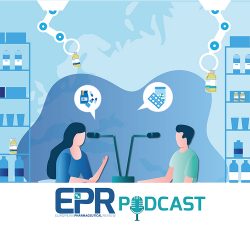
European Pharmaceutical Review podcast
EPR Podcast Episode 11 – Developing vaccine technologies – Giulia Giordano and Mark Doherty, GSK

With COVID-19 having intensified the focus on vaccine development over the past few years, in this podcast we are exploring how manufacturing and formulation of vaccines has advanced and some promising technologies for the future. For this episode, European Pharmaceutical Review’s Hannah Balfour is joined by two representatives from GSK: Giulia Giordano, PhD, Vaccine Development Leader, and Professor Mark Doherty, Senior Manager of Global Medical Affairs, Vaccines.
What are some of the latest developments in vaccinology?

Professor Mark Doherty, Senior Manager of Global Medical Affairs, Vaccines
Mark explains that there are four key areas of development for vaccines over the past few years, including in the areas of formulation or delivery (eg, using messenger RNA [mRNA]) and manufacturing. “What they have in common is that we are moving away from processes which were very heavy on synthetic chemistry… instead we are moving to a much more biologically-focused technology or family of technologies, where things that we used to do synthetically are actually coded for by recombinant production organisms,” he stated. The benefits of such a shift are that recombinant biological production techniques simplify the conjugation and purification steps involved in vaccine manufacturing, enabling vaccines to be brought to market faster.
An additional development is the enhancing understanding of how vaccines work at a molecular level, and using this as the basis of vaccine development, something which Mark states has benefited the industry by significantly reducing failure rates.
What is GMMA and why is it a potentially key vaccine technology?

Giulia Giordano, Vaccine Development Leader
Giulia is the Vaccine Development Leader for the generalized modules for membrane antigens (GMMA) technology that GSK is working to develop. She explains how GMMA, outer membrane vesicles produced by genetically modified Gram-negative bacteria, can form the main component of a vaccine. “There are intrinsic characteristic of GMMA that make them a really good choice for a vaccine, for example, their size. So usually they are around 25 to 250nm and that is the right size to facilitate the draining into the lymph node and the uptaking from immune cells,” she stated. Giulia also describes how, coming from bacteria, GMMA is self-adjuvanted because it expresses components such as pathogenic associated molecular patterns (PAMPs), which stimulate an immune response.
“With this technology we can display to the immune system several antigens simultaneously,” she adds, explaining how for bacterial infection and overcoming antimicrobial resistance, the ability to display multiple antigens from several strains of the same or different species of bacteria is key. “GMMA allows us to have one single component with several antigens in the surface, and this is why we call it a multivalent approach.”
The GMMA technology, because of its relatively simple manufacturing process, may also be of critical importance to low income countries. Giulia describes how the process involves just three steps: “One fermentation and two steps of filtration. The first filtration is to separate the bacteria from GMMA and the second filtration is to purify, so to separate GMMA from smaller components.”
You can learn more about GMMA in this article published in Frontiers in Immunology.
How are adjuvanted systems developing?
Mark explains how the advancing molecular understanding of adjuvants is enabling the personalisation of vaccines to optimise vaccine responses for various age groups.
“Over the last 20 years when it comes to adjuvant development, we have moved away from the idea that it is purely an inflammatory or a damaging effect which leads to the increased immune response, to a recognition that there is actually a level of recognition by the innate immune system of these molecules,” states Mark. Moreover, he describes how, at the molecular level, the immune response to an adjuvant is directed by the combination of receptors that recognise PAMPs; “it is the kind of receptors which activate and the magnitude of that activation can actually lead to a whole host of different outcomes.”
This understanding is what allows vaccine developers to design adjuvants that direct targeted immune responses and overcome challenges such as immune senescence in older adults. “What are adjuvants? It has moved beyond just boosting your overall response to specifically manipulating the kind of immune response that you want,” Mark states.
To hear how adjuvant production is developing, as well as how GSK goes about selecting which vaccine technology is applied to develop each vaccine programme, tune in to the episode.
Please join the conversation and leave your thoughts in the comments – we love hearing your feedback – and look out for our next episode coming soon!
The post <em>EPR</em> Podcast Episode 11 – Developing vaccine technologies – Giulia Giordano and Mark Doherty, GSK appeared first on European Pharmaceutical Review.